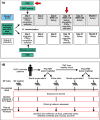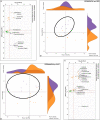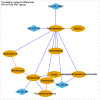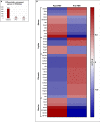Reduced alcohol preference and intake after fecal transplant in patients with alcohol use disorder is transmissible to germ-free mice
- PMID: 36261423
- PMCID: PMC9581985
- DOI: 10.1038/s41467-022-34054-6
Reduced alcohol preference and intake after fecal transplant in patients with alcohol use disorder is transmissible to germ-free mice
Abstract
Alcohol use disorder is a major cause of morbidity, which requires newer treatment approaches. We previously showed in a randomized clinical trial that alcohol craving and consumption reduces after fecal transplantation. Here, to determine if this could be transmitted through microbial transfer, germ-free male C57BL/6 mice received stool or sterile supernatants collected from the trial participants pre-/post-fecal transplant. We found that mice colonized with post-fecal transplant stool but not supernatants reduced ethanol acceptance, intake and preference versus pre-fecal transplant colonized mice. Microbial taxa that were higher in post-fecal transplant humans were also associated with lower murine alcohol intake and preference. A majority of the differentially expressed genes (immune response, inflammation, oxidative stress response, and epithelial cell proliferation) occurred in the intestine rather than the liver and prefrontal cortex. These findings suggest a potential for therapeutically targeting gut microbiota and the microbial-intestinal interface to alter gut-liver-brain axis and reduce alcohol consumption in humans.
© 2022. The Author(s).
Conflict of interest statement
The authors declare no competing interests.
Figures









References
Publication types
MeSH terms
Substances
Grants and funding
- P40 OD010995/OD/NIH HHS/United States
- P30 DK034987/DK/NIDDK NIH HHS/United States
- I01 CX001076/CX/CSRD VA/United States
- P50 AA022537/AA/NIAAA NIH HHS/United States
- R01 MH084894/MH/NIMH NIH HHS/United States
- F30 MH116550/MH/NIMH NIH HHS/United States
- P30 DK056350/DK/NIDDK NIH HHS/United States
- I01 BX004033/BX/BLRD VA/United States
- P30 ES010126/ES/NIEHS NIH HHS/United States
- R21 TR003095/TR/NCATS NIH HHS/United States
- P01 DK094779/DK/NIDDK NIH HHS/United States
- R21 AA026629/AA/NIAAA NIH HHS/United States
- IK6 BX004477/BX/BLRD VA/United States
- R01 MH111940/MH/NIMH NIH HHS/United States
- R01 AA026347/AA/NIAAA NIH HHS/United States
- R01 DK104893/DK/NIDDK NIH HHS/United States
- R01 DK057543/DK/NIDDK NIH HHS/United States
LinkOut - more resources
Full Text Sources
Medical
Molecular Biology Databases

